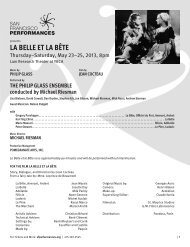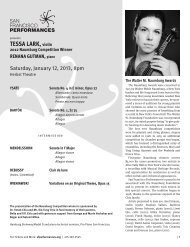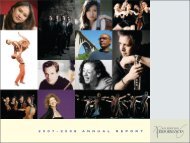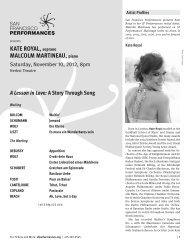ANNE-SOPHIE MUTTER, violin LAMBERT ORKIS, piano
ANNE-SOPHIE MUTTER, violin LAMBERT ORKIS, piano
ANNE-SOPHIE MUTTER, violin LAMBERT ORKIS, piano
Create successful ePaper yourself
Turn your PDF publications into a flip-book with our unique Google optimized e-Paper software.
presents<strong>ANNE</strong>-<strong>SOPHIE</strong> <strong>MUTTER</strong>, <strong>violin</strong><strong>LAMBERT</strong> <strong>ORKIS</strong>, <strong>piano</strong>Monday, March 4, 2013, 8pmDavies Symphony HallMOZART Sonata for Piano and Violin in G Major, K.379Adagio; AllegroThema con variazioni: Andantino cantabileSCHUBERT Fantasy in C Major for Violin and Piano, D.934Andante molto; Allegretto; Andantino;Allegro vivace; PrestoINTERMISSIONLUTOSLAWSKIPartitaAllegro giustoAd libitumLargoAd libitumPrestoArtist ProfilesSAINT-SAËNS Violin Sonata No.1 in D minor, Opus 75Allegro agitato; AdagioAllegretto moderato; Allegro moltoSan Francisco Performances presents Anne-Sophie Mutter and Lambert Orkis for the eighthtime, including their San Francisco recital debutin 1988. They also appeared in 1991, 1995,1997, 2000 and in co-presentations with theSan Francisco Symphony in 1998 and 2008.Anne-Sophie MutterThe Shenson Virtuosi Violin Series is made possible by Fred M. Levin andNancy Livingston, the Shenson Foundation.This performance is made possible in part through the generous support of RoswithaGoeppert-Woolley and Charles Miller and the Bernard Osher Foundation.Tonight’s concert is dedicated to Audrey Avis Aasen-Hull.Anne-Sophie Mutter is represented by Columbia Artists Management Inc.5 Columbus Circle, New York, NY 10019-1412 info@cami.comHamburg Steinway Model D and <strong>piano</strong> technical services, Pro Piano, San Francisco.For more than 35 years, <strong>violin</strong>ist Anne-Sophie Mutter has sustained a career ofexceptional musicianship with an unwaveringcommitment to the future of classicalmusic. Since her international debut at theLucerne Festival in 1976, followed by a soloappearance with Herbert von Karajan at theSalzburg Whitsun Concerts, Ms. Mutter hasappeared in all the major concert halls ofEurope, North and South America and Asia.In addition to performing and recordingthe established masterpieces of the <strong>violin</strong>repertoire, Ms. Mutter is an avid championof 20th- and 21st-century <strong>violin</strong> repertoireFor Tickets and More: sfperformances.org | 415.392.2545 | 1
in both orchestral and chamber music settings.Cited by The Chicago Tribune for doingmore than “any living <strong>violin</strong>ist to enrichthe late 20th-Century <strong>violin</strong> repertory,” Ms.Mutter has had new works composed forher by Sebastian Currier, Henri Dutilleux,Sofia Gubaidulina, Witold Lutoslawski, NorbertMoret, Krzysztof Penderecki, Sir AndréPrevin and Wolfgang Rihm. She also devotesher time to numerous charity projects andsupports the development of young, exceptionallytalented musicians.In the year 2013 Anne-Sophie Mutter performsin Asia, Europe and North America.The season’s schedule solidifies the <strong>violin</strong>ist’smusical versatility and her unparalleleddistinction in the world of classical music.Anne-Sophie Mutter maintains her focuson bringing new works to concert halls. Theworld premiere of Sebastian Currier’s RingtoneVariations for <strong>violin</strong> and double bass,a work commissioned by her foundation,provides the prelude for a following AsianTour with the Mutter Virtuosi. This ensembleunder the musical direction of the <strong>violin</strong>istherself, consists of 14 current and formerscholarship students of the Anne-SophieMutter Foundation. Further highlights of theyear include a concert in celebration of composerWitold Lutoslawski’s 100th birthday inWarsaw and a recital in Carnegie Hall on the25th anniversary of Miss Mutter’s debut inthe concert hall.The honors afforded Anne-Sophie Mutterfor her many recordings include theDeutscher Schallplattenpreis, the RecordAcademy prize, the Grand Prix du Disque,the Internationaler Schallplattenpreis aswell as several Grammys. On the occasion ofthe <strong>violin</strong>ist’s 35th stage anniversary in 2011,Deutsche Grammophon launched a comprehensiveboxed set with all of the artist’s DGrecordings, extensive documentation and sofar unpublished rarities.In 2008, Miss Mutter established theAnne-Sophie Mutter Foundation whose objectiveis the further strengthening of theworldwide promotion of top young musicaltalents. In 2012, she was bestowed the AtlanticCouncil’s distinguished artistic leadershipaward. She has been awarded theBrahms prize, the Erich-Fromm prize andthe Gustav-Adolf prize for her social involvementin 2011; and wide-ranging recognitionincluding an honorary doctorate from theNorwegian University of Science and Technologyin Trondheim, the St. Ulrich Europeanpeace prize, the Cristobal Gabarron artsaward, the International Ernst von Siemensmusic prize and the Leipzig Mendelssohnmusic prize.Lambert OrkisRemembering Audrey Avis Aasen-HullPhoto : Rosalie O’ConnorLambert Orkis has received internationalrecognition as chamber musician, interpreterof contemporary music, and performer onperiod instruments. He has appeared worldwidewith <strong>violin</strong>ist Anne-Sophie Mutter since1988 and performed in recital with cellist MstislavRostropovich for more than 11 years.His distinguished career includes appearanceswith cellists Lynn Harrell, AnnerBylsma, Daniel Müller-Schott, and Han-NaChang, <strong>violin</strong>ist Julian Rachlin, and violistSteven Dann, and he has performed with theVertavo, Emerson, American, Mendelssohn,Curtis, and Manchester string quartets. As soloisthe has made appearances with conductorsincluding Christoph Eschenbach, MstislavRostropovich, Leonard Slatkin, RafaelFrühbeck de Burgos, Günther Herbig, KennethSlowik, John Mauceri, Robert Kapilow,Leon Fleisher, and others.A multi-Grammy Award nominee, his widediscography comprises works of the classical,romantic, and modern eras on manylabels. With Anne-Sophie Mutter he has frequentlyrecorded for Deutsche Grammophon,winning a Grammy Award for “Best ChamberMusic Performance” for the Beethoven<strong>piano</strong> and <strong>violin</strong> sonatas and a 2006 Chocde l’année award from the French magazineLe Monde de la Musique for the Mozart<strong>piano</strong> and <strong>violin</strong> sonatas audio recording.Audio and video recordings of the Brahms<strong>piano</strong> and <strong>violin</strong> sonatas with Ms. Mutterwere released in 2010. He has recorded worksof Brahms, Schumann, and Chopin/Franchommewith Dutch cellist Anner Bylsma.With violist Steven Dann, he appears on anATMA Classique disc of works by Brahms,and has released discs on Bridge Records ofsolo works written for him by George Crumb,Richard Wernick, and James Primosch.At Carnegie Hall and the Kennedy Center,Mr. Orkis premiered Wernick’s Piano Concertowhich was written for him with the NationalSymphony Orchestra, Mstislav Rostropovichconducting. He recorded the work for BridgeRecords with Symphony II of Chicago. TheEuropean premiere took place with Mr. Orkisand Het Residentie Orkest of The Hague, TheSan Francisco Performances and the worldof classical music are saddened by the loss ofAudrey Avis Aasen-Hull, who died at her home inMenlo Park on October 31, 2012. Pictured here ata San Francisco Performances event in the late1990s, she was always an elegant and charismaticpresence brimming over with joyous charm. Andshe had a proclivity for wearing wonderful hats.Audrey Avis was born in Coquille, Oregon andgraduated with a degree in music from the Universityof Oregon. She received her Master’s Degreein Musicology from Stanford University. Shewas a professional in both <strong>piano</strong> and <strong>violin</strong> andwas very involved with the Music Teachers’ Association of California, teaching in the SanFrancisco public schools before becoming a private music teacher in Menlo Park. Her studentsremember her teaching excellence and technical proficiency and her ability to teachmusic appreciation, theory, harmony, and history. She performed regularly during her entirelife and often played chamber music with friends in her home. In 1962 she marriedJames Byrne Hull who survives her and who took wonderful care of her in her last years.Audrey Avis made very important contributions to the music community. Some of theorganizations which she loved and made gifts to include San Francisco Performances,the San Francisco Symphony, Music@Menlo, California Institute of Technology’s musicprogram, California Summer Chamber Music, Lively Arts at Stanford, the San FranciscoConservatory of Music and the Music Academy of the West.2 | For Tickets and More: sfperformances.org | 415.392.2545
Netherlands. In both instances, the composerconducted.Lambert Orkis has recorded solo discs as fortepianistof Schubert works for Virgin Classics.As founding member and fortepianist of theSmithsonian Institution’s Castle Trio, he hasgiven many performances, including severalcycles of Beethoven’s 28 major works for forte<strong>piano</strong>and strings, and produced highly regardedrecordings of Beethoven and Schubert trios.His most recent solo releases on the BridgeRecords label include, as fortepianist andpianist, three separate performances ofBeethoven’s Appassionata sonata, using instrumentsbased upon Viennese <strong>piano</strong> buildingdesigns that represent three snapshots intime of Viennese keyboard evolution. Anotherdisc features <strong>piano</strong> music by Louis MoreauGottschalk performed on an 1865 Chickeringconcert grand <strong>piano</strong> from the collections of theSmithsonian Institution in Washington, D.C.Lambert Orkis has held the position ofPrincipal Keyboard of Washington’s NationalSymphony Orchestra since 1982 and has performedchamber music with NSO PrincipalCellist David Hardy since 1983.Beethoven Past & Present, Mr. Orkis’ mostrecent release on Dorian Recordings and incollaboration with Mr. Hardy, contains twocomplete performances of Beethoven’s eightworks for <strong>piano</strong> and cello, performed on bothmodern and period instruments.As a founding member of the Kennedy CenterChamber Players, he has appeared with thisensemble before enthusiastic audiences in theKennedy Center’s Terrace Theater and throughoutthe Washington metropolitan area since2003. Recordings by this ensemble that havebeen released on the Dorian label include TheBeauty of Two (duos for <strong>piano</strong> with cello [byGrieg and Martinů performed with Mr. Hardy],viola [Hindemith], and flute [Poulenc]), and AnEmotional Journey, Clarinet Works of JohannesBrahms (two sonatas performed with NSOPrincipal Clarinetist Loren Kitt and, joined byMr. Hardy, the clarinet trio).In April, Mr. Orkis will participate as a distinguishedperforming artist and teacher for theMusica Viva Festival 2013 which will take placein Sydney, Australia. He has twice served as jurorof, and performed for, the Trondheim (Norway)International Chamber Music Competitionand Festival. The Carnegie Hall InternationalAmerican Music Competition for Pianists andthe Kennedy Center Friedheim Awards Competitionhave engaged him as judge on several occasions.As an Honored Artist for Taiwan’s NewAspect International Music Festival, he performedand presented master classes in Taipei.He is professor of <strong>piano</strong> at Temple University’sEsther Boyer College of Music andDance in Philadelphia, having received theFaculty Award for Creative Achievement.In acknowledgment of his accomplishments,he has been honored with Germany’s Cross ofthe Order of Merit.A Special Note by Lambert OrkisThe collaborative process of choosing aprogram for our joyful reappearance on theSan Francisco Performances concert serieswas really quite easy. Though we had originallyplanned works that included the SanFrancisco premiere of Sir André Previn’sViolin Sonata #2 for Violin and Piano, circumstancesnecessitated the postponementof the World Premiere and, subsequently, localpremieres of this work scheduled for the2012–2013 season. Anne-Sophie, Sir André,and I felt badly about this, especially as wehad prepared this splendid new piece andwere very anxious to perform it this season.As Sir André’s composition played animportant role in the construction of ourplanned 2012–2013 recital program and as weand our European audiences had really enjoyedour 2011–2012 selections, we decided toplay last season’s European program for ourUnited States audiences this year.One might well ask, why Mozart, Schubert,Lutoslawski and Saint-Saëns? Well, Anne-Sophie and I have been playing together fora long time. In fact, if you want to hear theWorld Premiere of Sir André’s Violin Sonata #2for Violin and Piano, you can come to CarnegieHall in New York City on Saturday, December14, 2013 at which time we will celebratetwenty-five years of performing together.During those twenty-five years, we havepresented a lot of repertoire including the cyclesof Mozart, Beethoven and Brahms sonatas.There are some major works that we havenot played together but we have exploredmost of the really important ones. Most certainly,our first years together were spent examiningthe gems of this <strong>violin</strong>/<strong>piano</strong> genre.There were works each of us were eager toplay. Mentors and friends suggested works,such as the Respighi Sonata for Violin andPiano, which we might not have otherwiseconsidered. As we both have a fascination fornew music, we would introduce works of ourfavorite modern composers to each other. Wecelebrated the year 2000 by playing music ofGeorge Crumb, a wonderful composer withwhom I had had a long and fruitful association.In that year, we premiered an important<strong>violin</strong>/<strong>piano</strong> sonata from one her favoritecomposers, Krzysztof Penderecki.As the patina of passing years burnishedour joint efforts and though we did not wantto suppress our interest in exploring workswe had not yet performed, it became clear tous that revisiting beloved repertoire shouldbecome part of our programming and thatdesire is reflected in the works we bring toyou tonight.Of course, the Mozart sonata we play thisevening is part of our more recent repertoire,is one of our favorites, and it opens the programon a surprisingly dramatic note.The Schubert Fantasy was performed by usin the early 1990s and we have fond memoriesof it being one of the most challenging,beautiful, and hauntingly moving works forthis instrumental combination. Each night,when we play this heart-felt music, we aretruly re-climbing a rarefied mountain filledwith hidden beauties and deep emotions.The Lutoslawski Partita is also from ourearly years together. As the first half of theprogram consists of classical/romantic leaningmaterial, we felt that something contrastingin style was needed to begin the secondhalf. Now, modern music can be off-puttingto some audiences, but Lutoslawski is oneof those composers who manages to soundmodern yet is exciting to contemporary listeners.True, it is for us a highly demandingwork, but we loved playing it years ago andlove playing even more now.The Saint-Saëns Sonata for Violin and Pianoin D minor was new to us last season. Whenwe were discussing repertoire, I looked intomy CD library and sent to Anne-Sophie anumber of works that were of interest to meFor Tickets and More: sfperformances.org | 415.392.2545 | 3
that we had not played, one of which was thisparticular sonata. We both took note that thelast movement would provide quite an ambitiousand exciting end to the program, and aswe pride ourselves in taking on challenges,decided to learn and program the work. Inthe process of studying the piece together,we formed our own point of view and grew tolove playing it. The sonic content is uniquelyFrench and, if one allows a food metaphor, thefinal movement is a magnificent dessert and isthe grand finale to a great musical feast.And it is in the spirit of our shared love ofbeauty, deep feeling and the joy of seeminglylimitless human expression that we perform thisprogram of wonderful music for you tonight.–Lambert OrkisProgram NotesSonata for Piano and Violinin G Major, K.379Wolfgang Amadeus MozartBorn January 27, 1756, SalzburgDied December 5, 1791, ViennaMozart was called to Vienna in March 1781along with the rest of Archbishop Colloredo’sparty to attend the festivities surrounding theaccession of Emperor Joseph II. Relations betweenthe composer and the Archbishop hadbeen strained for some time, and after severalstormy scenes in Vienna Mozart was finallygiven his release “with a kick on my arse…by order of our worthy Prince Archbishop.”Before his release, however, Mozart had beenrequired to compose music for a party thearchbishop gave in Vienna on April 8. In aletter to his father that day, he described theSonata in G Major as “a sonata with <strong>violin</strong> accompanimentfor myself, which I composedlast night between eleven and twelve (but inorder to be able to finish it, I only wrote outthe [<strong>violin</strong> part] and retained my own part inmy head).” The way the rest of us stay up anextra hour to pay the bills, Mozart stayed upand dashed off this masterful music.The Sonata in G Major has an unusual form:it is in only two movements, but the Allegro ispreceded by a slow introduction so long thatit almost becomes a distinct movement of itsown. Given the fact that Mozart wrote the keyboardpart for himself, it comes as no surprisethat that instrument plays so important a role,even if Mozart played the entire part frommemory at the Archbishop’s party. The introductionitself is full of florid writing–rolledchords, turns, grace notes–but the moodchanges sharply at the Allegro, which movesinto G minor. The keyboard again takes thelead, but this time the theme, motto-like inits shortness, is full of snap, of Beethoveniandrive. The second subject of this sonata-formmovement is canonic, with fragments tossedbetween the two instruments. Following adramatic development, the movement drawsto a close on its opening theme.After the fury of the Allegro, the final movementreturns to the serene G Major of theintroduction. This a theme-and-variationmovement, with a graceful opening melodymarked Andantino cantabile followed fivevariations. At the close of the fifth variationMozart repeats the theme verbatim andcloses with a brief coda. Each variation is intwo parts, with the second section generallythe more dramatic. Throughout this movement–byturns gentle and brilliant–the keyboardretains its prominence, as if Mozartwere keeping himself firmly at center stage,protesting the Archbishop’s strictures on himeven as he served them.Fantasy in C Major forViolin and Piano, D.934Franz SchubertBorn January 31, 1797, ViennaDied November 19, 1828, ViennaSchubert wrote the Fantasy for Violin andPiano in December 1827, only eleven monthsbefore his death at age 31. The music was firstperformed in public on January 20, 1828, by<strong>violin</strong>ist Joseph Slavik and pianist Karl vonBocklet, one of Schubert’s close friends. Thatpremiere was a failure. The audience is reportedto have begun to drift out during theperformance, reviewers professed mystification,and the Fantasy was not published until1850, twenty-two years after Schubert’s death.Hearing this lovely music today, it is hardto imagine how anyone could have had troublewith it, for the only thing unusual aboutthe Fantasy is its structure. About twentyminutes long, it falls into four clear sectionsthat are played without pause. Though itseems to have some of the shape of a <strong>violin</strong>sonata, the movements do not developin the expected sonata form–that may havebeen what confused the first audience–andSchubert was quite correct to call this piecea “fantasy,” with that term’s implication offreedom from formal restraint.Melodic and appealing as the Fantasy maybe to hear, it is nevertheless extremely difficultto perform, and it demands players of thegreatest skill. The first section, marked Andantemolto, opens with shimmering ripplesof sound from the <strong>piano</strong>, and the lovely <strong>violin</strong>line enters almost unnoticed. Soon, though,it rises to soar high above the accompanimentbefore brief cadenza-like passages for<strong>violin</strong> and then <strong>piano</strong> lead abruptly to theAllegretto. Here the <strong>violin</strong> has the dance-likeopening idea, but the <strong>piano</strong> immediatelypicks this up, and quickly the instruments areimitating and answering each other. The <strong>violin</strong>writing in this section, full of wide skipsand string-crossings, is particularly difficult.The third section, marked Andantino, is aset of variations. The <strong>piano</strong> alone plays themelody, which comes from Schubert’s songSei mir gegrüsst (“Greetings to Thee”), writtenin 1821. Some of Schubert’s best-knowncompositions–the “Death and the Maiden”Quartet and the “Trout” Quintet–also builda movement out of variations on one of thecomposer’s own songs, and in the FantasySchubert offers four variations on Sei mirgegrüsst. These variations grow extremelycomplex–some have felt that they grow toocomplex–and once again the music makesgreat demands on its performers. At the conclusionof the variations, the shimmering musicfrom the beginning returns briefly beforethe vigorous final section, marked Allegro vivace.Schubert brings the Fantasy to a closewith a Presto coda, both instruments strainingforward before the <strong>violin</strong> suddenly flashesupward to strike the concluding high C.PartitaWitold LutoslawskiBorn January 25, 1913, WarsawDied February 7, 1994, WarsawLutoslawski’s Partita began with a slightmisunderstanding that nevertheless had aprofound impact on the music. Lutoslawskiwas commissioned by the St. Paul ChamberOrchestra to compose a work for <strong>violin</strong>ist PinchasZukerman and pianist Marc Neikrug, andbecause the commission had come from anorchestra, Lutoslawski assumed that he wasto write for <strong>violin</strong> and orchestra. He conceiveda piece for <strong>violin</strong> and an orchestra that had alarge <strong>piano</strong> part, and only when compositionwas underway did he learn that the commissionwas in fact for a chamber piece for only<strong>violin</strong> and <strong>piano</strong>. So Lutoslawski had to switchgears: he recast the piece just for <strong>violin</strong> and<strong>piano</strong> and completed it in the fall of 1984;Zukerman and Neikrug gave the premiere onJanuary 18, 1985 in St. Paul. For the composer,however, the original orchestral conception remainedcentral to how he thought about thismusic–he came back to this score in 1988 andmade an arrangement for <strong>violin</strong> and orchestra.continued on page 54 | For Tickets and More: sfperformances.org | 415.392.2545








